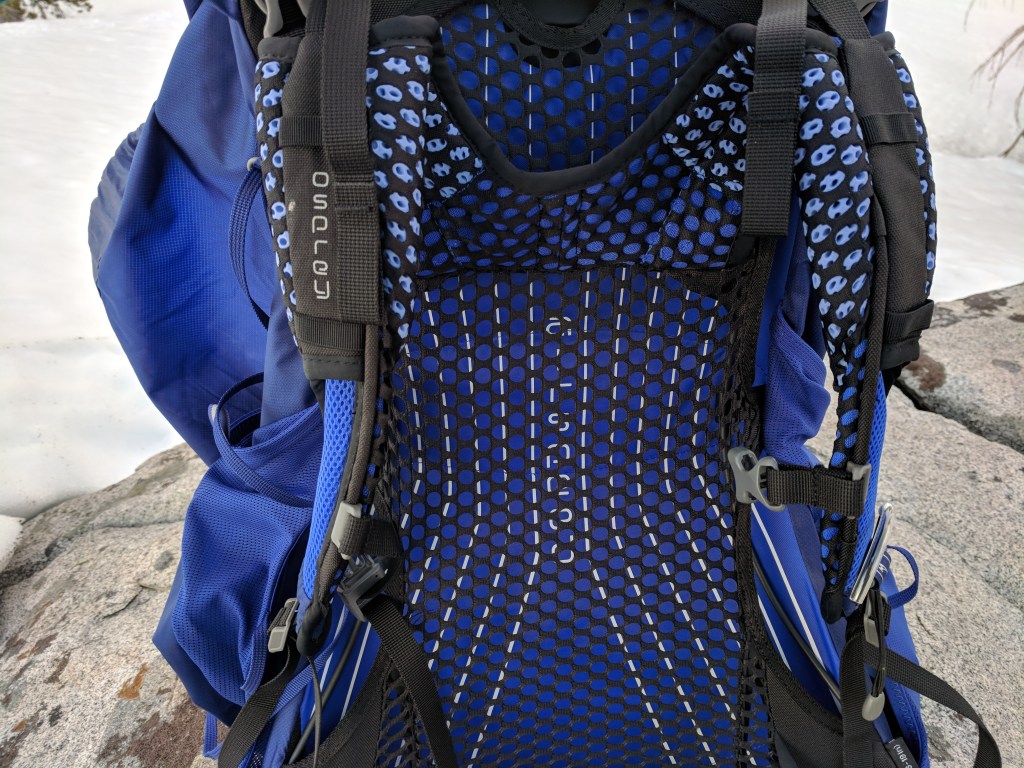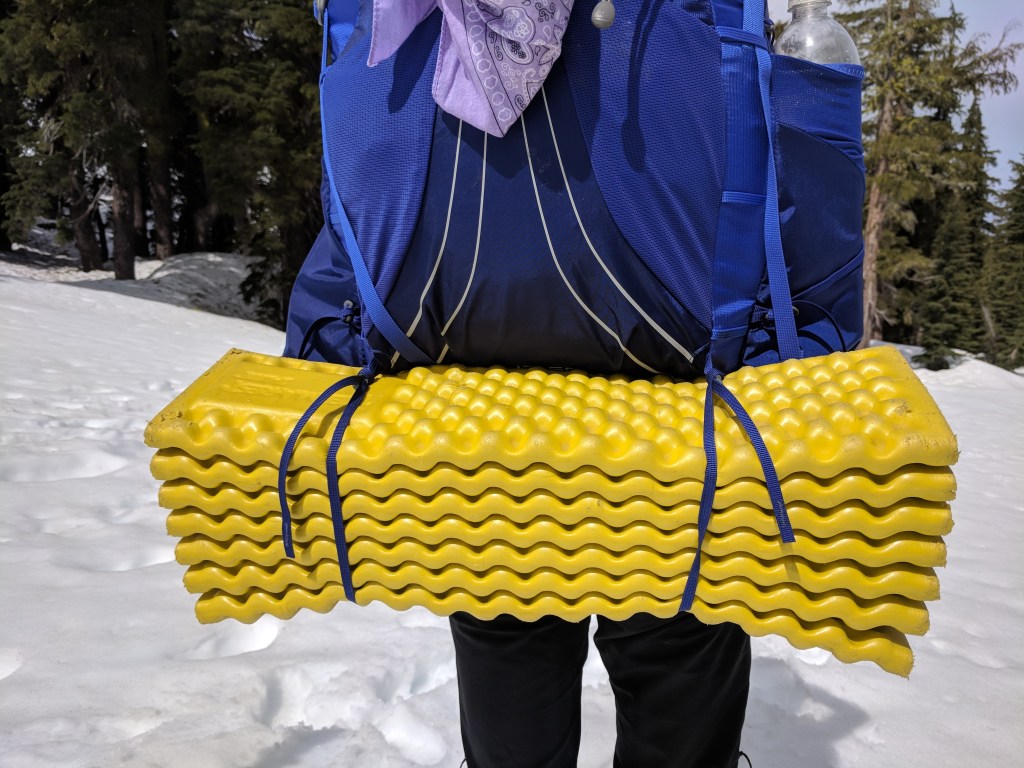Backpackers looking to enjoy their time in the wilderness face a perennial question: What’s more important, having comfortable gear or lightweight gear? Your backpack is one of the most important items that impacts how you feel on the trail and how quickly you can move during your outdoor adventures. Osprey has long created packs with suspension systems that perform well with heavy loads during long days on the trail. But now, the company has finally created a lightweight, women-specific pack that maintains comfort for a range of load weights: the Osprey Eja 58.
The sister pack of the Osprey Exos, the Eja features Osprey’s AirSpeed™ 3-D tensioned mesh backpanel but still weighs just 2 pounds, 10 ounces in sizes small and medium. Thanks to lighter fabric, thinner straps, smaller buckles and a streamlined suspension system, the Eja is 2 pounds lighter than comparable women-specific backpacking packs like the Osprey Ariel AG 65, but still offers the durability and comfort to manage heavy loads.
I tested the Osprey Eja with a 40-pound carrying weight on trails up and down Bernal Heights Park in San Francisco and with 30 pounds of weight on a 16-mile backpacking trip across dirt trails, flowing streams and shin-deep snow in the California Sierra. Here’s what you need to know about this women-specific hauler that bridges the gap between ultralight and ultra-comfortable.
Pack pros:
- Lightweight
- Comfortable for a range of carrying weights
- Mesh back panel, shoulder straps and hipbelt are breathable and sweat-wicking
Pack cons:
- Tiny buckles and thin straps throughout the pack are difficult to manipulate
- Lack of padding in the backpanel can make items inside the pack rub uncomfortably against your back
Comfort
Osprey is known for making comfortable, well-ventilated backpacking packs. The Eja is no different. The pack’s tensioned, breathable backpanel is well-ventilated and the ExoForm™ shoulder straps and hipbelt wick sweat and provide enough cushioning to maintain comfort with heavier load weights.
Whereas some ultralight packs can’t (comfortably) handle the heavier loads required for week-long trips with bear cans, this pack can, and will be my pack of choice for an 80-mile trip that will take me both on established, maintained trails and through the unbridled backcountry in Sequoia and Kings Canyon.

Suspension
The Eja has Osprey’s AirSpeed™ suspension system, which puts your back against a suspended mesh panel and creates air space between your back and the body of the pack itself. I found the back suspension to be quite comfortable with a single caveat: Because there is no padding in the body of the pack, large, bulky items like bear cans can poke through that air gap and rub against the small of your back. I found this easy to manage through careful packing—I put my sleeping clothes around the base of the bear can and between the bear can and the exterior of the pack—but it does require some extra forethought to make sure the suspension feels comfortable.

Fit
The Osprey Eja has a women-specific fit that works. Osprey designed both the suspension system and the hipbelt specifically with female hikers in mind. The hipbelt fits snugly and can be easily adjusted depending on your body type and how you like a pack to sit on your hips. The shoulder straps have enough padding to be comfortable, but not so much padding that they ride up or rub uncomfortably. The sternum strap is well placed to sit right at your sternum and is adjustable within a 4-inch range. With just the right amount of padding and adjustability, I found the Osprey easy to tweak so it carried well on the trail.
Durability
The body of the Eja is made of 100-denier nylon and the bottom is made of 210-denier nylon. This makes the materials in the pack slightly less durable than the 210-denier nylon you see in a similar backpacking pack like the Ariel AG 65, but also lighter. After hauling this bag through variable, rocky Sierra conditions, I’d trust the Eja for bushwhacking but not for activities like mountaineering where you might have it around a lot of sharp objects. However, if anything does happen to the pack, you are protected by Osprey’s warranty, which allows you to contact the manufacturer to request free repairs. Plus, when you travel with a standard repair kit including tape and patch kits, you’ll be ready to handle any minor field repairs on your own.
Apart from the fabric, the buckles, which are quite small, are another potential weak point of this pack. Apart from the hipbelt buckle, many buckles throughout the pack are only about 1 inch long and ¼ inch in thickness, and seem like they could snap if put under unusual strain or break from wear and tear over time. Fortunately, if you need to make a minor repair like replacing a buckle (as opposed to more extensive repairs that might require you to send the pack to Osprey), the company also states on its website that it will send you replacement parts at no cost.

Organization
When it comes to organization, this pack passes with flying colors—it has everything you need and nothing you don’t. The sleeping pad strap is an unusual design, but works well. Rather than having buckles, the sleeping pad straps cinch up at the top. Although this would be annoying to adjust multiple times a day, if you strap your sleeping pad on at the start of the day and take it off when you’re making camp, it works just fine. The water bottle pockets are large enough to hold a Nalgene water bottle but compress enough to easily hold other, less bulky items you may want throughout the day like rain gear, hats or, in my case, dog hiking booties. The front mesh pocket works perfectly for storing maps, rain gear or wet items you want to separate from the rest of your gear.
My favorite feature of this pack is the pack’s floating lid. The main zipper that gives you access to the inside of the lid sits farther toward the top of the lid than towards the base, which makes it easy to reach in and rummage around for the items you want. The second mesh pocket under the lid is a great addition for items you want to keep stowed throughout the trip, like car keys or a wallet. And if you want to pare this pack down to its lowest possible weight, you can drop approximately 3 ounces by removing the sleeping bag strap, the compression straps and the floating lid. After you’ve removed the lid, there’s a secondary flap that extends and clips over the body of the pack to protect the pack interior from the elements. Whereas many packs have removable lids, few have this extra flap that extends over the top of the pack after the lid has been removed. This is a great feature if you want to trim weight but still need that extra protection for your gear from the weather.
